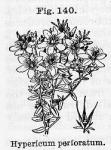
 Preparation: Tincture of Hypericum
Preparation: Tincture of Hypericum
The leaves and flowering tops of Hypericum perforatum. Linné.
Nat. Ord.—Hypericaceae.
COMMON NAME: St. John's wort.
ILLUSTRATION: Johnson's Med. Bot. of N. A., Fig. 112.
Botanical Source.—This plant has a perennial, woody, tufted, fusiform, tortuous, somewhat creeping root. Its stem is 2-edged, branchiate, erect above, curved below, branched, and from 1 to 2 feet high. The leaves are very numerous, elliptical or ovate, obtuse, opposite, entire, marked with pellucid dots, of a pale-green color, from 6 to 10 lines long, one-third as wide, the ramial leaves being much smaller. The flowers are numerous, of a bright-yellow color, and borne in dense, forked, terminal panicles. The calyx is persistent; and the sepals are 5, acute, lanceolate, connected at the base, with 6 dark-colored glands. Petals 5, twice as long as the sepals, ovate, obtuse, yellow, dotted, and streaked with black or dark purple. Stamens numerous, united at base, divided into 3 sets with small anthers. Styles 3 short, erect; stigmas small. The capsule is roundish, 3-celled and 3-valved; the seeds numerous, small, and roundish. The whole herb is dark-green, with a powerful scent when rubbed, and stain the fingers dark-purple, from the great abundance of colored essential oil (L.—W.).
History and Chemical Composition.—St. John's wort is an herb abundantly growing in this country and Europe, and proving exceedingly annoying to farmers. The flowers appear from June to August. It has a peculiar, terebinthine odor, and a balsamic, bitterish, rather astringent taste. It imparts its properties to water, alcohol, ether, oils, or alkaline solutions. Other species of Hypericum are possessed of medicinal properties, notably the Hypericum sarothra, Michaux, pine-weed or orange-grass, growing in sands, which has aperient qualities. An allied plant, the Ascyrum crux-Andreae, Linné, or St. Andrew's cross, has been locally applied to glandular indurations and swellings. Hypericum contains a volatile oil, a resin, tannic acid and coloring matter (Blair, Amer. Jour. Pharm., Vol. II, p. 23). Pectin is also present. The red coloring principle is a resinous body known as hypericum red. The odor of this principle is similar to that of the flowers. Karl Dieterich (Pharm. Centralh., 1891, p. 683) macerated the flowers with 90 per cent alcohol, and obtained a tincture of a rich red color, containing a mixture of two coloring matters, a yellow principle soluble in petroleum ether, and a red coloring matter, insoluble in this solvent. The red principle, in solid form, was a resinous mass of a green lustre, soluble in alcohol with red color, and resembling carthamin red; insoluble in fatty, but soluble in ethereal oils. Acids dissolve it with red, alkalies, chloroform, benzol and carbon disulphide with green color. The substance does not possess any advantage over other indicators in alkalimetry. When exposed to air in thin layers, it turns greenish at once. The aqueous extractive matter of the flowers contains calcium, magnesium, potassium, and oxalic, sulphuric and carbonic acids.
Action, Medical Uses, and Dosage.—Astringent, sedative, and diuretic. Used in suppression of the urine, chronic urinary affections, in diarrhoea, dysentery, worms, jaundice, menorrhagia, hysteria, nervous affections with depression, hemoptysis, and other hemorrhages. Hypericum has undoubted power over the nervous system, and particularly the spinal cord. Homoeopathic physicians regard it as the arnica of that structure. It is used in injuries of the spine and in lacerated and punctured wounds of the limbs to prevent tetanic complications and to relieve the excruciating pains of such injuries (Scudder). It is highly valued by Webster in spinal irritation when, upon gentle pressure upon the spinous processes of the vertebrae, burning pain is elicited. Throbbing of the whole body in nervous individuals, fever being absent, is said to be a good indication for hypericum. The usual method of administration is: Rx Tincture of hypericum, gtt. x to xxx; aqua, fl℥iv. Mix. Sig. Teaspoonful every 1 or 2 hours. Externally, hypericum may be used in fomentation, or used as an ointment for dispelling hard tumors, caked breasts, bruises, ecchymosis, swellings, ulcers, etc. The blossoms, infused in sweet oil or bear's oil, by means of exposure to the sun, make a fine, red balsamic ointment for wounds, ulcers, swellings, tumors, etc. A very excellent ointment for tumors, ecchymosed conditions, etc., may be made by adding to 1 pound of lard, ½ pound of the recent tops and flowers of St. John's wort, and ½ pound of fresh stramonium leaves; bruise all together, expose to a gentle heat for an hour, and strain. Dose of the powder, from ½ to 2 drachms; of the infusion, from 1 to 2 fluid ounces. The dose of the strong tincture is from ½ to 10 minims. Ɣ The saturated tincture of the fresh herb (℥viii to alcohol, 76 per cent, Oj) is nearly as valuable as that of arnica for bruises, etc., and may be substituted for it in many instances.
Specific Indications and Uses.—Spinal injuries, shocks, or concussions; throbbing of the whole body without fever; spinal irritation, eliciting tenderness and burning pain upon slight pressure; spinal injuries, and lacerated and punctured wounds of the extremities, with excruciating pain; hysteria; locally to wounds, contusions, etc.

